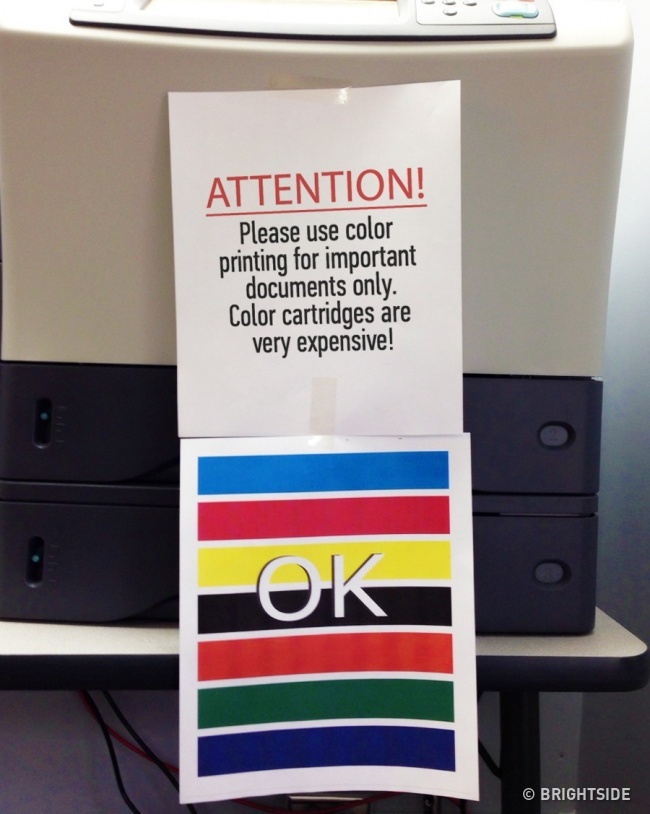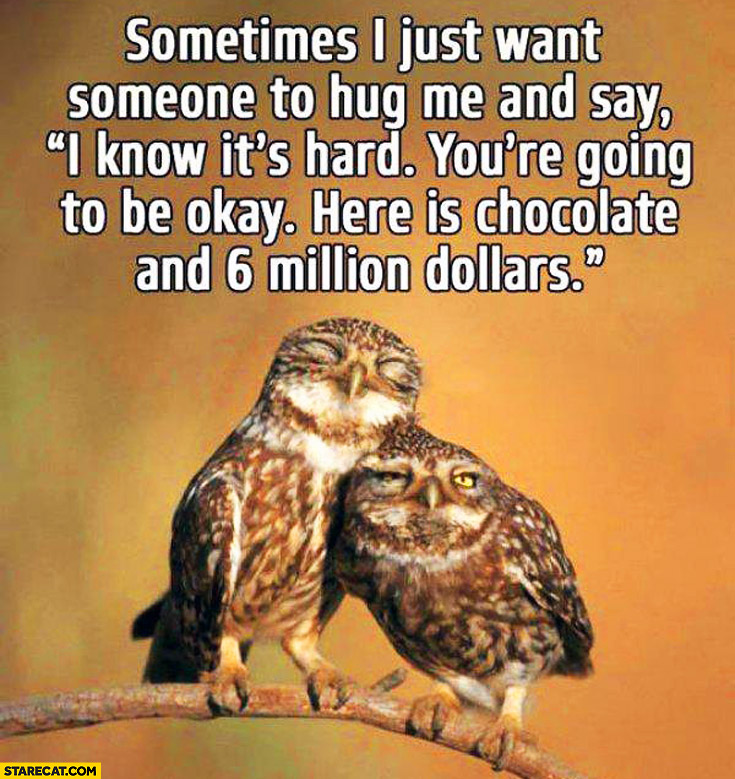It’s funny how humour boosts creativity
Ooops!
It was late on a Thursday evening when Helen finally finished up her work and got ready to leave the office. As she made her way out, she found the CEO standing in front of a shredder with a piece of paper in her hand.
"Listen," said the CEO "this is a very sensitive and important document here, and my secretary has gone for the night. Can you make this thing work?"
As a young executive, Helen was eager to be of assistance. "Certainly," she said and she turned the machine on, inserted the paper and pressed the start button.
"Excellent, excellent!" said the CEO as her paper disappeared inside the machine. "Thanks for your help. I just need one copy."
The creative origin story of Comic Relief
This Friday, March 19, is Red Nose Day in the UK. It is run by the charity Comic Relief which was launched in 1985 live from a refugee camp in Sudan during the Ethiopian famine. Red Nose Day is a campaign to end child poverty, using humour and grassroots fundraising as the basis of its approach. The national fundraising day is held every two years and to date has not only raised over GBP1 billion in the UK, but has inspired similar fundraising initiatives for children in need in over 30 countries around the world.

The origin story of Comic Relief is a very creative one. At the time that the charity was founded, the UK fund-raising industry was highly saturated. Thousands of charities hustled for a piece of the same donor pie and donors were overwhelmed with choice (there were 600 cancer charities and 200 homeless charities for London alone.) Charities had similar strategies, which included year-round marketing and annual fund-raising galas. The marketing was solemn and guilt-inducing and the increasingly grand gala events were designed to bestow honour on the most generous donors. The aid organisations pursued the same type of donors (wealthy individuals in their 50s and 60s) pressing for ever-greater donations. Donors developed donor fatigue from constant and wide-spread solicitation, overwhelm from the grim campaigns and suspicion about the effectiveness of fund use.
The founders of Comic Relief used creative thinking to take a completely fresh approach. They eliminated the fancy galas, did away with year-round marketing and dropped the focus on wealthy donors. Instead, they launched a nation-wide day for everyone to get involved in doing something funny for money. The event happens only every two years to make it more special. It’s spearheaded by a live Telethon hosted by a glittering of celebrities who participate for free.
The idea is that everyone from kindergarten to care home, council estate to grand country home, can do something small for a laugh. For example, a London travel agent, who was a chatterbox of note, got her friends to sponsor her not to say a word for 24 hours and a particularly hairy man from Manchester waxed off all his body hair to raise funds. Both raised GBP500 for Comic Relief. The community-based approach has been hugely successful with Comic Relief achieving an incredible 96% brand awareness and Red Nose Day becoming akin to a national holiday.
The link between humour and creativity
The Comic Relief story inspires me to think more creatively and question my assumptions when solving problems and pursuing opportunities. It also reminds me of the power of humour, which is what I want to share with you today. I’m talking about humour as an umbrella term covering play, jokes, stories, and games.

Winter Running Tips for Masochists by Semi-Rad (Brendan Leonard) - I love this guy
There are strong links between humour and creativity.
- Both humour and creativity seek to make connections that are not obvious. They reach out for remote elements to produce something novel. (What do you call a Frenchman wearing sandals? Phillipe Phillope.)
- They use a switching of frame of reference. (Two men meet on opposite sides of a river. One shouts to the other, "I need you to help me get to the other side!" The other guy replies, "You're on the other side!")
- The element of surprise is prevalent in humour and also in creativity. (Two cows are grazing in a field. One cow says to the other, "You ever worry about that mad cow disease?" The other cow says, "Why would I care? I'm a helicopter!")
- Creativity and humour break some frameworks, but they adhere to others. So, though their outcome may be unexpected or unusual, they should be appropriate. (See the diagram at the end about positive and negative humour. We are going for positive humour here, of course.)
It’s not a surprise to me that one of the top five regrets of the dying is that “I wish I had let myself be happier.” We spend so much time working hard to achieve goals that are supposed to make us happy, that we make ourselves miserable in the process. As we lose our sense of humour, so our creativity diminishes as well. Let’s not go that route anymore!
Why humour is good for creativity

If you want to be more creative, invest some energy in adding fun and humour to your life. Here’s why.
- Humour relaxes us and we are more inspired when we are relaxed. Laughing helps to control brain levels of the neurotransmitter serotonin, similar to what antidepressants do.
- There is a liberating and energising power in humour which makes us less likely to listen to the dissenting voice of our inner critic and more likely to take a creative leap.
- Using humour teaches us to take sudden shifts in perspective or thinking patterns. This helps us to see problems from different points of view and think more laterally and creatively.
- Humour is a stressbuster. When stress hormones like such as adrenaline and cortisone inhibit creative thinking, humour can balance these out with dopamine, serotonin and oxytocin which in turn help us to make associations, see possibility and think creatively.
What the research shows

I’m not just making this stuff up. Here are some findings taken from the research paper: Humour and Creativity (Eliav, Miron-Spektor and Bear) that might make you raise your eyebrows (unless you’ve had Botox, in which case, you can just widen your eyes a little.)
- people with a strong sense of humour (measured as a trait or an ability) are more likely to generate creative ideas (Goodchilds, 1972)
- people who engaged in improvisational comedy training show more creativity in a subsequent product generation task, than people who did not engage in this training (Kudrowitz, 2010).
- framing a task as fun and silly resulted in better creative performance than when framing the task as serious (Friedman, Forster, & Denzler, 2007)
- watching a comedy film increased performance on insight creativity tasks after the film (Isen, Daubman, & Nowicki, 1987).
These findings suggest that: Engaging in humour, before or while performing a task that requires creativity, has a positive effect on creative output.

And in the workplace context, in particular:
- the presence of just one member who uses humour deliberately and frequently is enough to improve group performance in problem solving tasks (Smith & Goodchilds, 1963).
- leaders who use humour with their people improve communication and knowledge sharing (Wood et al., 2011) which enhances creativity (Pan, Sun, & Chow, 2012; Volmer, Spurk, & Niessen, 2012).
- leaders who express humour effectively inspire their people to find creative and innovative solutions to complex problems (Lee, 2015).
- employees working in organisations in which expressions of humour are legitimate and frequent, tend to be more creative (Ekvall, 1996; Isaksen & Lauer, 2002; Slatten, Svensson & Svaeri, 2011).
Wowsers. That’s a pretty strong case for lightening up a little. So how should we go about adding fun and humour to our lives, especially when we may be stuck behind a mask or working from home?
10 ways to add more humour to your life

(This is one of my favourite Calvin & Hobbes strips. As I child I was terrified of breaking my parents' binoculars!)
According to entrepreneur and author, Marie Forleo, the first three steps must involve your philosophy and your intent. Get these right and the others will follow.
- Choose to lighten up. Understand that adding more humour to your life is a choice. Give yourself permission to lighten up, regardless of your situation.
- Believe you can do it. Adding humour and fun to your life is within your control. You don’t need to be Trevor Noah or Ali Wong to have more laughs. There are small, easy steps that everyone, including you, can take to add fun to daily life.
- Do it daily. This needs to be a daily practice. Don’t try to do this only once a month. Get into the habit of having a laugh every single day.
- Watch comedy. Whether it’s a feature film on TV on the weekend, or three minutes of stand-up comedy on your phone at the end of your working day, let yourself unwind and have a good belly laugh from time to time. Take humour breaks! My favourite stand-up comedians are Trevor Noah, Eddie Izzard and Michael McIntyre. As a family just love watching The Goldbergs sitcom and Tali’s Wedding Diaries/ Tali’s Baby Diaries, both of which often have us crying with laughter. (Tali is Julia Anastasopoulos aka SuzelleDIY.)
- Capture funny moments from your day. Each night make a habit of quickly noting down anything humorous that happened during the day. See if you can get to three every day. By doing this you will stimulate your Reticular Activating System which will engage your brain to be on the lookout for funny things around you. There could be a lot that you are missing. Also, you will prepare your mind to see the funny side of things that could have otherwise stressed you out. (If you have small children, please write down the funny things they say, or you will forget them! Early last year, my youngest, Gabriella was reading to me. She pronounced ‘circle’ as ‘kir-kil’. I said: “No, Gabs, it’s a soft ‘c.’” “Oh,” she said, then very softly, in a whisper, she said, “kir-kil.”
- Frame tasks as fun. Just as Mary Poppins famously turned cleaning up the children’s nursery into a fun game and song for the children, you too can turn doing dishes, cooking dinner or grocery shopping into an enjoyable event (unfortunately without her magic powers!) Put on music, try something new, make it into a dance or pretend you are in a movie. If you have children, get them in on it by having them come up with ideas for the task or play certain roles. As Marie Forleo says, you can bring the party to anything you do! (see link in references below for her fun video about this.)
- Reward yourself. If you are up to your neck in work or stress (or both), give yourself a break and lighten up by treating yourself to something relaxing or fun. Take yourself off for a coffee at your favourite coffee shop or go browse books in an inviting bookstore for a little while. Give yourself a pat on the back and do something enjoyable even if it is quick. If you struggle with rewarding yourself, imagine you were a friend. How would you advise a friend to reward themselves?
- Plan a fun event. Having something fun and exciting to look forward to relieves stress and boosts our creativity. Anticipation creates discipline, helps with patience and pushes us to accomplish those tasks that we may not necessarily want to do. Every year, my friends and I plan a roving dinner in our neighbourhood. We have starters, mains and dessert at three different houses hosted by 2-3 couples at each home. We choose a theme for the dinner and each house selects an interpretation of that theme which directs their food, beverages, decoration, music and costumes. So far our themes have included: James Bond Movies, Football World Cup Nations, Times in History (or the Future), Colours and Countries.
- Re-frame boring or stressful situations. If your network drops for the fifth time in a week because the workers installing new water pipes have cut the fibre cable again, then try to re-frame the situation in your mind. (My exact situation last week.) Can you see the funny side? What would a meme about your situation look like? Anger and despair can spiral upwards if you give them free reign and that is not going to help you at all. Laughing is not going to bring your internet connection back, but it will help lower your blood pressure and enable you to come up with some solutions. I’ve now set up an analogue (non-digital) desk in my office (thanks Austin Kleon for this suggestion in Steal like an Artist.) Although we have backup data via mobile broadband devices, I sometimes use the start of the internet downtime as a reminder to sit at my analogue desk and do some writing by hand, sketching out of mind maps and organising of plans using stickies. It’s great to get away from the computer sometimes and use fun stationery. (Yes, I’m one of those people who squeals quietly in glee and wiggles their fingers as they enter a stationery store.)
- Lighten up your home office. Add some colour, something unexpected or a quirky object or two to your home office. Put some cartoon strips, meme or sayings which make you smile where you can see them regularly.
So there you have it. Ten easy ways you can inject some humour and fun into your daily life. Which one will you start with? I’d love to hear what you do or see a pic. Comment on social tagging @creativitywakeup and #havemorefun.
And finally, let’s end with some silliness
- How does a squid go into battle? Well-armed.
- What's the best thing about Switzerland? I don't know, but their flag is a huge plus.
- What's E.T. short for? Because he's only got little legs.
- What's the difference between a hippo and a zippo? One is really heavy, and the other is a little lighter.
- What do Alexander the Great and Winnie the Pooh have in common? Same middle name.
- What do you call bears with no ears? B–
- What's a foot long and slippery? A slipper.
- Exaggerations have become an epidemic. They went up by a million percent last year.
- They all laughed when I said I wanted to be a comedian. Well, they're not laughing now!
- I told my physical therapist that I broke my arm in two places. He told me to stop going to those places.

References:
Bronnie Ware (201) Regrets of the Dying. Hay House Inc. (Bronnie was a palliative care nurse who spent several years caring for patients in the last 12 weeks of their lives.)
Chan Kim and Renee Mauborgne (2017) Blue Ocean Shift: Beyond Competing Proven Steps to Inspire Confidence and Seize New Growth. Hachette Books.
Eliav, E., Miron-Spektor, E., Bear, J. Humour and creativity. Technion-Israel Institute of Technology and Stony Brook University.
Kelsey Borrensen (220) The Psychological Benefits Of Having Things To Look Forward To. Huffpost. May 21, 2020.
Marie Forleo, 3 Ways to Have More Fun, Be Spontaneous, and Enjoy Your Life Again (9:04 mins)
The Conversation (2020) Laughing Is Good for Your Mind and Your Body, Here’s What the Research Shows. Neuroscience News. November 29, 2020
Video by Ketut Subiyanto from Pexels

Diagram by Robert Wood, Nadin Beckmann, Fiona Pavlakis. Humour in organisations: No laughing matter.



